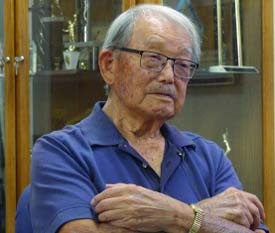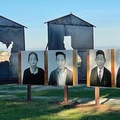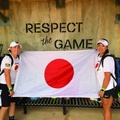Jim Morita a concentration camp survivor of World War II was old enough at the time to see the impact imprisonment made on the inmates. The heartbreak among the older prisoners was evident.
“I could see it on their faces the older prisoners the adults,” Morita recalled. “Like those in their 50’s. They suffered. Teenagers in the camp like me, we hadn’t lost as much. We had a ‘to hell with it attitude.’”
In 1942 the U.S. Government shamefully locked up Japanese Americans, loyal U.S. citizens, because of their race.
The older prisoners were devastated the most. They lost everything they had worked to build, their businesses, property, possessions and freedom. All they had left were their lives.
Some lost those too. Unable to deal with it some committed suicide, while other prisoners already in delicate health at the start succumbed from the brutal experience.

Though he didn’t witness it firsthand Morita was close by. His brother Don saw it, the murder of a prisoner by a camp guard who panicked and overreacted, a prisoner killed for no reason at all. The crime was never investigated and remains unpunished to this day.
In fact at the time American society hardly took notice of the incident. The Los Angeles Times appeared to blame the trouble solely on the prisoners with a mocking headline that read, “The Japanese are Celebrating Pearl Harbor.”
Morita would agree the only justice left in the case is to tell people of it so they will know, so it’s not forgotten.
Morita was a prisoner at Manzanar a camp located in a remote part of Northeastern California. Deliberately mislabeled by the government a “War Relocation Center,” it was in reality a concentration camp for prisoners including children, the elderly and pregnant women whose only crime as American citizens was—-they looked Japanese.
Manzanar was one of 10 such camps located in remote areas of the U.S. Southwest. Numerous smaller prisons for Japanese and Japanese Americans were run by the U.S. Dept. of Justice (DOJ).
Manzanar was noted as a camp for imagined troublemakers. Those who protested their illegal imprisonment, who refused to sign a loyalty oath (they felt they were already loyal), or who offended in some way their captors.
It was apparently an example in the government’s eyes of having all the rotten apples in one barrel so to speak.
There was fear among the prisoners.
“We had thought we were going to be sent to a camp in Rohwer, Arkansas,” Morita said. “When my mother (Masano Morita) heard that we were going to Manzanar instead, she became hysterical. We had heard that people were dying there.”
How the prisoners reacted to their incarceration could differ widely. Some who appeared to disagree with their imprisonment were seen by the timid souls in the camp to be trouble makers, those who because of their defiance could get the more compliant prisoners into trouble also. The government system accomplished what any police state wants. Get some of the prisoners to act as government cronies (informers) and turn the prisoners against each other—-divide and conquer, keep the prisoners docile, submissive.
It was another step toward isolation, dehumanization.
Tensions increased at the camp. On Dec. 6, 1942, almost a year to the day after the Japanese attack on Pearl Harbor the situation boiled over.
A camp prisoner Fred Tayama was attacked by a group of prisoners for allegedly espousing a pro-government War Relocation Authority (WRA) viewpoint. Harry Ueno was arrested for the crime and held in the camp jail. Ueno was popular with the prisoners. They demanded his release.
A crowd formed near the camp police station where Ueno and two other prisoners were being held.
Soldiers responding to the scene formed a rank in front of the police station and carried a variety of weapons, rifles, pistols, shotguns and machine guns, two of them heavy tripod mounted weapons.
The soldiers donned gas masks.
When an MP officer ordered the crowd to disperse and they did not the soldiers threw tear-gas and vomit-gas bombs into the crowd. The crowd reacted in panic, running in all directions, some toward the soldiers. An MP sergeant yelled “Remember Pearl Harbor, hold your line!”
The soldiers opened fired without orders to do so, three bursts of submachine gun fire and three shotgun blasts. Among the prisoners 10 suffered gunshot wounds and two were killed, Henry Ito a 17-year-old from Los Angeles and James Kanegawa, 21 from Tacoma.
According to Densho Encyclopedia in its historical description of the event a few members of the crowd had taunted and threw stones at the MPs before they opened fire.
“Some in the crowd were just spectators,” Morita said. “My brother (Don Morita) saw it and ran away. He came screaming and running into the barracks. The next day the authorities declared martial law.”
Morita said he was about one mile away in the prison barracks when it happened and didn’t hear the shooting.
A rumor unproven to this day is that one of the prisoners in the camp jail was a Japanese American a former enlisted U.S. military man who had been helping the government and was being kept in the jail away from the prisoners for his own safety.
“The rumor we heard was that this Japanese American sergeant had adopted an English sounding name and had been in World War 1 with Sergeant Alvin York,” Morita said.
York was one of the most decorated soldiers of World War 1 including winning the Congressional Medal of Honor the nation’s highest award.
“We had heard that the prisoner had been York’s right-hand man,” Morita added. “I was 15 when this happened. I was in the camp from 1942 to 1945.”
Morita had been born in Fresno and moved in 1929 with his parents to Florin, today a neighborhood in Sacramento.
“I went to a segregated school,” Morita said, “all Japanese (American). My dad (Kamekichi Morita) immigrated from Japan to Hawaii and later married my mother (Masano). It was a picture wedding (marriage based on a photo, the bride at first sight unseen).”
Morita’s father made a living as a barber.
“Both my parents were born in Japan in the Hiroshima area, that’s where there were poor farmers,” Morita noted.
When the government ordered the arrest and deportation of Japanese Americans to prison camps Morita was a sophomore at Elk Grove High School.
“I couldn’t graduate,” he said.
Morita said several years ago he met Bob Matsumoto a former advertising executive and Sacramento artist who designed an iconic logo (poster) to memorialize the suffering endured by the prisoners—three strands of barbed wire colored red, white and blue against a black background.
“Bob Matsumoto, his grandfather was a friend of my dad’s,” Morita said. “His dad was my baseball coach. I didn’t know Bob until I read an article (2017) about his 9066 artwork.”
Executive Order 9066 signed by President Franklin D. Roosevelt ordered the arrest and imprisonment of 115,000 Japanese and Japanese Americans living along the west coast. Matsumoto’s artwork including the barbed wire poster has been exhibited at the Museum of Modern Art and copies of the symbol adorn posters and tee shirts sold at the Japanese American National Museum (100 N. Central Ave., Los Angeles).
Matsumoto and his family like Morita had been imprisoned at Manzanar.
Morita said to pass time in the camp the prisoners formed their own baseball teams. They played on a diamond carved out on bare ground originally created as a fire break.
“I used to pitch,” Morita said. “I was on a team the Red Sox, and the Solons. They were named after the Sacramento Solons (a minor league team that moved to Hawaii in 1961 and became the Hawaii Islanders).”
Morita said the camp had 17 teams. Some were named for the communities from which the player-prisoners had come, for example the San Pedro Yogore (means dirt in Japanese) and the San Fernando Aces.
“They were a good team,” Morita said of the Aces.
Morita said he was old enough to be well aware that what the government was doing to the prisoners was a great wrong. He recalled that in one case a Caucasian man promised to take care of property owned by a Japanese American so the man could take back possession of his property when he returned from the camp. Instead he forced the man to sell his property at an outrageously low price.
“There was another case,” Morita said. “A man promised to hold a prisoner’s property for him, but this time when the man returned from the camp there was money in the bank for him, the place was kept up, the property returned. So there were honest people out there.”
During his imprisonment in 1944 Morita was briefly released from Manzanar to pick sugar beets and potatoes on a farm in Pocatello Idaho because of a shortage of farm labor workers. One day Morita was walking when he came upon two white service men who threatened him.
“One said, ‘you’re a Jap!’” Morita said. “He took off his jacket as if to fight. I thought if you come at me I’m going to give you a kick. Just then a police patrol car came by and the policeman saw what was happening. That saved my butt.”
Upon release from Manzanar another incident happened.
“I was in Fresno shopping with someone and we were going home,” Morita said. “There was a crease in my vehicle. Somebody had taken a shot at it.”
After the war and freedom Morita was drafted into the U.S. Army in 1953 and served doing occupation duty on the island of Okinawa. After the service he met and married his wife Dorothy and the couple had two adopted children, Dana and David. Today he has four granddaughters (Dorothy passed in 2008).
Morita’s four brothers all served in the military including Don in the U.S. Army, Eugene in the Air Force, Ken in the Army and John in the U.S. Navy.
His son David entered the U.S. Marines and also served on Okinawa.
Morita made his living after the war as a gardener and then a barber. Today he lives in the Central Valley town of Lodi. He is 97.
“I still go a couple mornings a week to cut hair at the Eucalyptus Barber Shop,” Morita said. “I still play golf. I used to play 18 holes, but now I play nine holes walking.”
His schedule was temporarily suspended recently from a hip replacement surgery.
Asked how he managed to live so long, Morita said he gave up smoking in 1966 and does not drink alcohol.
“I also love to take a hot bath,” he said. “Soaking in a hot tub, that’s what they do in Japan.”
Morita said when he and his parents were released from Manzanar they had to start again from scratch.
“We didn’t have anywhere to go,” he said. “We moved to Ivanhoe (near Visalia) and lived in a barn with a dirt floor. We were picking grapes doing farm labor. Later we could find a way to kid about it we could laugh at it. But at the time it wasn’t funny.
I was an 18-year-old. I said to myself, I don’t have a future.”
However, Morita indicated that with the history of racism, of being imprisoned, uprooted and with all the pain, some good happened. People knuckled down, achieved new careers and lives, and eventually pursued professions, many of them formerly unavailable to the Japanese Americans of the past.
“There was bad but some good came too,” Morita said.
*This article was originally published in the NikkeiWest in 2023.
© 2023 John Sammon






